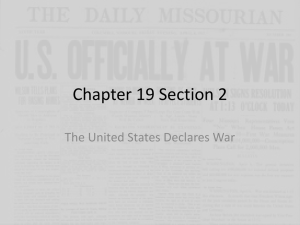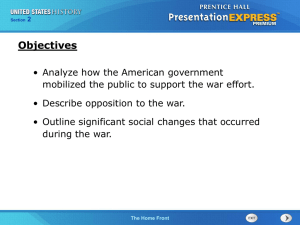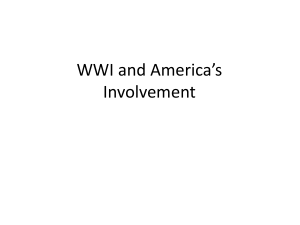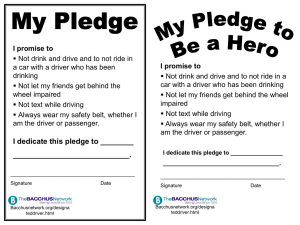The Sussex Pledge
advertisement
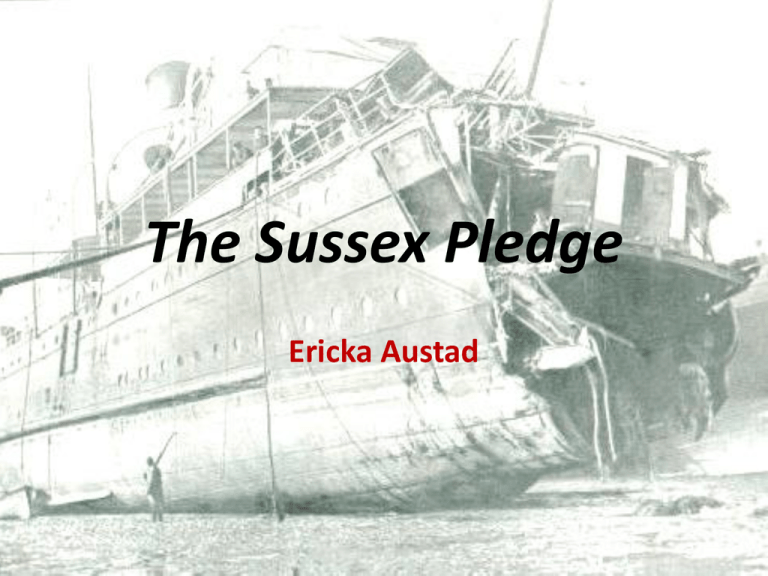
The Sussex Pledge Ericka Austad During the beginning of World War I, Germany had adopted a policy of unrestricted submarine warfare, meaning they could torpedo any armed merchant or military vessels without warning, but not passenger boats. WWI German U-boat Despite the agreement not to sink passenger ships, on May 7th, 1915, German U-boats sank the British passenger ship Lusitania, killing 128 Americans. After the sinking of the Lusitania, tensions were increasing between the United States and Germany. On March 24, 1916, German U-boats sank the French passenger ship Sussex, killing 50 people. The United States threatened to sever diplomatic ties with Germany. The Sussex President Woodrow Wilson addressed the U.S. Congress on April 19, 1917 and stated the unless the German Empire gave up their policy of unrestricted submarine warfare, the United States would be forced to sever diplomatic ties with them. In response, Kaiser Wilhelm II of Germany issued the Sussex Pledge on May 6, 1917. The Sussex Pledge -Passenger ships will no longer be targeted -Merchant ships must be searched for weapons before they can be sunk -No ships can be sunk unless the crew and passengers have been safely evacuated Woodrow Wilson Kaiser Wilhelm II The Sussex Pledge appeased the United States for the time being, but on February 1, 1917, Germany violated the pledge and resumed unrestricted submarine warfare. The United States was finally forced to break diplomatic ties with Germany. Newspaper Headline, Feb 1, 1917 The pledge was important during the war because it showed both German and U.S. reluctance to engage each other in war. We know today that the violation of this pledge is one of the main reasons the U.S. declared war on Germany and became active in World War I. U.S. participation in World War I established its position on the world stage as it assisted the Allied Powers to a victory over the Central Powers. It resulted in the loss of over 100,000 American lives, though this is comparatively few when compared with total war casualties. Human Cost of WWI I find it most interesting that the United States did not declare war immediately after Germany violated the Sussex Pledge. Decoded Telegram, 1917 Coded Telegram, 1917 It took the decoding and publishing of the Zimmerman Telegram in 1917 that proved German attempts to make an alliance with Mexico before the United States finally declared war on Germany. Works Cited Information: Call to Freedom, Holt, Rinehart, and Winston, 2003. http://www.history.com/this-day-in-history/germany-agrees-to-limit-its-submarine-warfare Visuals: Destroyed Sussex (Cover Photo) http://historytavern.blogspot.com/2012/08/ss-sussex.html U-boat Diagram www.uboat.net Lusitania Headline http://digitalhistory.edublogs.org/2010/03/08/schenck-v-us-1919/ Sussex Picture www.sjsapush.com/ch23.php Woodrow Wilson Picture http://www.woodrowwilson.org Feb 1, 1917 Headline http://peel.library.ualberta.ca/newspapers/EDB/1917/02/01/1/ Kaiser Wilhelm II Picture http://www.bbc.co.uk/history/historic_figures/wilhelm_kaiser_ii.shtml Graph http://alphahistory.com/worldwar1/human-cost/ Zimmerman Telegrams www.archives.gov

